A service excellence training guide

Unlock the potential of your best brand ambassadors
READ MORE
WATCH VIDEO


Unlock the potential of your best brand ambassadors
READ MORE
WATCH VIDEO
In today’s healthcare, long-term care and senior living establishments, we strive to provide the best dining experience. High-quality food and dining programs start with excellent service. Whether feeding a patient at a hospital, a resident of long-term care or an independent living community, a staff member or a visitor, the goal is service excellence.
The physical environment and social interactions your guests experience factor into their overall health and well-being. Research shows people are likely to eat more in a welcoming, relaxed and friendly environment that supports a positive dining experience. Better appetites ultimately may improve intake and overall nutritional health.

Well-trained food and nutrition services team members have a critical role in guest satisfaction. All team members should understand that their actions directly influence not only satisfaction levels, but also health and well-being.
We want to ensure we are creating a dining experience that guests will be happy to share with their families and friends.
As you review this guide, reflect on your practices and think about how this information can foster a high standard of hospitality that sets the table for success and creates an outstanding dining experience. Throughout this guide, we will refer to patients, residents, staff and visitors as “guests.” After all, we want to provide maximum service in each scenario.
1. Look sharp: personal appearance and hygiene
2. Set the table: prepare for service
3. Shape the experience: order of service
4. Mind your manners: service etiquette
5. Play it safe: safety/ sanitation practices
6. Drive home excellence: create the best experience
7. Anger management: resolving complaints
8. It’s the little things: body language, tone of voice, etc.
9. Diversity, equity, inclusion: create a welcoming climate
f Personal appearance in the dining room sets the tone for the meal experience.
f Communicate your expectations, and hold your team accountable.
Staff appearance sets the tone for the meal experience. Write your personal appearance and hygiene policy so it reflects your desired image and brand. Enforcing high standards promotes excellent customer service and safe, sanitary conditions.

Some general guidelines to consider in your policy:
• Uniforms must be neat and clean

f No visible stains.
f No outdoor clothes while serving guests.
f Crisp sleeve cuffs and collars.
f Shoes in good condition.
• Name tags should be clearly displayed.
f Help guests to identify who you are.
f Make guests comfortable calling staff by name.
f Wear them on the right (or in a standard spot).
• Jewelry is best kept to a minimum (to avoid hazards and contaminants).
f Wristwatches should be a tight fit.
f Well fitting wedding rings can be worn.
f Avoid bracelets and hoop earrings.
• Employees should be clean and well-groomed.
f Long hair should be pulled back.
f Facial hair should be neatly groomed.
f Fingernails should be short and clean.
f Deodorant should be used to avoid body odor.
f Limit perfume and cologne.
f Adhere to policies on piercings and tattoos.
• Team members should make one final check before serving.
f Have a mirror available to check appearance.
f Ensure you are presenting your best self.
f Ask a teammate to evaluate.
A correctly set table creates a welcoming experience. Ensure the table (and chairs) are clean before setting the table.
If you use table coverings, they should be clean and crisp. Tablecloths should be placed carefully with hems down and an even length hanging around the table.
Choose dinnerware carefully and check the condition. Be particular – plates, bowls, mugs, etc., should not be chipped. Glassware and silverware should be spot- and stain-free. In all cases, replace if necessary.
Generally speaking, if you don't want to eat or drink out of it, your guests won't either.
Formal settings and special occasions may require more than the traditional place setting. A more casual environment may require less.
• Linen napkins add an upscale, inviting tone.
• Creative napkin folds add flair.
• When possible, use flowers or a table tent as a centrepiece.
• Keep centrepieces simple when serving guests with dementia.
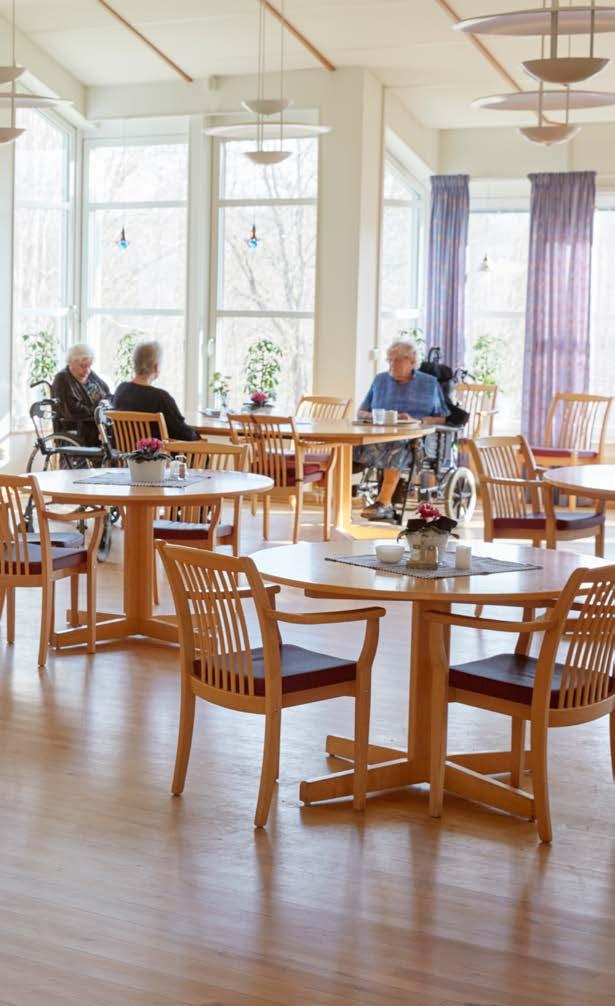
Some general rules apply to the traditional table setting:
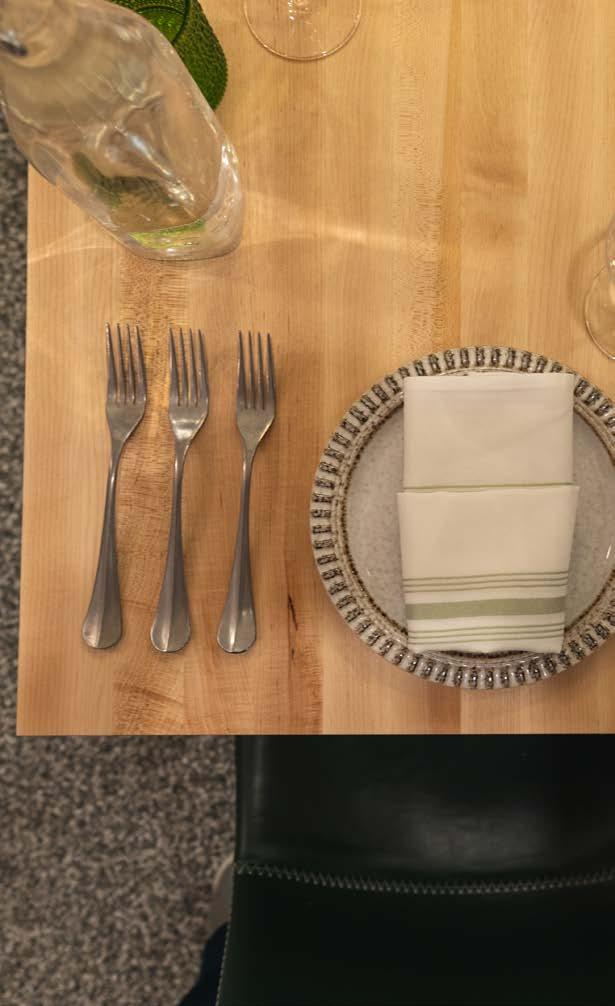
• Flatware is placed in the order of use, from the outside in.
f Forks go to the left of the plate.
f Salad fork (when used) goes on the outside.
f Knives go to the right of the plate, with blades facing the plate.
f Spoons go to the right of the knife.
f Soup spoon (when used) goes on the outside.
• The napkin goes to the left with the fork, or on the plate.
• Glasses go to the top-right of the plate.
• Bread plate and bread knife go to the top-left of the plate.
• Condiments go in the middle of the table.
f Be sure they are within reach and easy to open.
A great way to remember this order are the acronyms “FORKS” and “BED.” Each letter reminds you what to place from left to right.
f F – Place the forks first
f O – Represents the plate
f R – Move to the right of the plate
f K – Knife
f S – Spoon
f B – Bread plate
f E – Entreé
f D – Drink
The rules change for in-room tray delivery, but many principles still apply. The appearance of food and tableware affects the overall dining experience.

• Keep items neat and tidy.
• Follow traditional place-setting rules, understanding some service trays have dedicated sections and/or limited surface space.
f Glasses go to the top-right of the main entreé.
f Any accompanying dinnerware should go to the top-left of the main entreé.
• In addition to the meal requested, ensure condiments or extras are included on the tray (salt, pepper, margarine, straw, etc.).
• Always refer to a guest’s dining recommendations when preparing the meal tray.
f The consistency and appearance of table settings enhances the dining experience.
f Table settings remain important for in-room meal tray delivery.
Managing order of service puts guests at ease from the start.
The host is the first face a guest sees when entering the dining room. They begin the dining experience, setting a tone for the entire meal. Organizations without a host must train the wait staff to handle these important steps:

• Acknowledge guests with a friendly smile and eye contact.
• Greet guests with a sincere welcome, using proper titles and the guest’s name if you know it. “Good evening, Mrs. Brown” is more personal than, “Hi, table for two?”
• Connect with guests as they come in. Communicate upcoming events or recognize personal occasions (birthdays, anniversaries, etc.). Ask about their day.
• Escort guests to their seats.
• Provide guests the menu as they arive, or have menus (or digital options) already at the table.
When serving guests with support needs, be aware of the following:
1. Ensure assistive devices are placed out of the way for service but remain nearby and visible.
2. If residents have small appetites, serve nutrient-dense foods first.
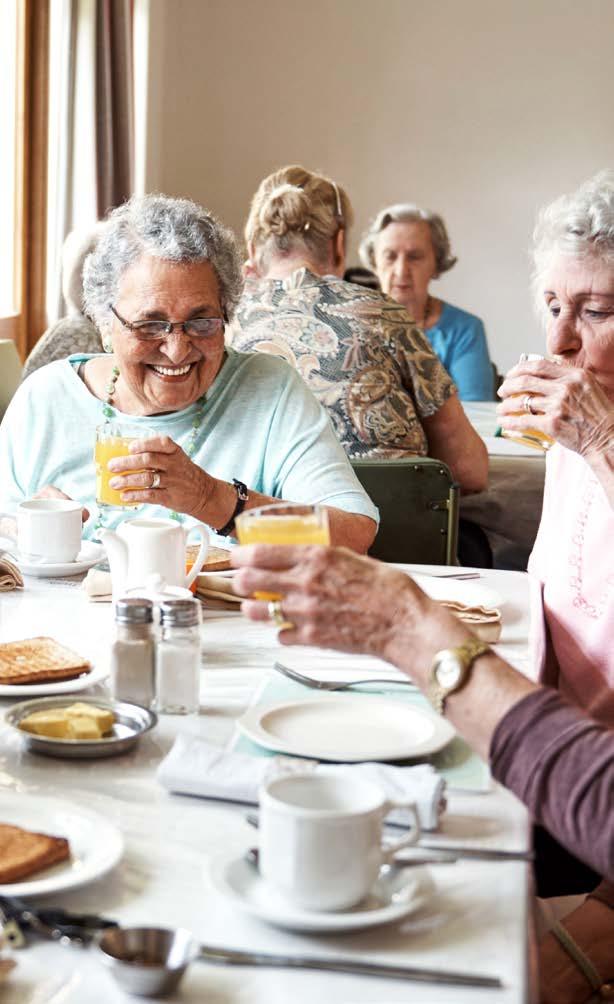
3. Avoid serving dessert before the main entreé.
4. Follow established guidelines to help guests with opening packages and cutting food.
5. Ensure guests are receiving the correct diet order and required adaptive equipment.
This team has many touch points with guests. Here are good practices for your server and wait staff to follow:
• Approach the table within a couple of minutes of the host leaving.
• Introduce yourself. If you are already acquainted, say hello.
• Ask if guests are ready to order beverages. Take beverage orders to give guests time to consider the menu.
• Return with beverages and take meal orders from left to right. Say thank you and collect menus, if required. Ask guests if there is anything else they need.
• Serve food in a logical order. For example, appetizer, entreé and dessert.
• Deliver entreé, identifying the meal as you place it in front of the guest. Check to see if there is anything they need (i.e., condiments, beverages, napkins, etc.).
• Clear dishes as guests finish. Clear the dishes from one course before the next course arrives.
• Check in. A few minutes after delivering a course, check in to see how guests are enjoying their meal. Scan the table to anticipate their needs.
f Are beverages full?
f Can empty dishes be removed?
• Remain alert and nearby, prepared to respond if needed.
• When everyone at the table is finished eating their entreé course, clear the table of everything except beverages and dessert fork.
• Serve dessert and tea or coffee, asking again if they need anything (i.e., napkins, beverages, flatware, etc.).
• Clear dessert dishes when guests finish. Check to see if there is anything else needed.
• Thank your guests for dining with you and tell them you look forward to serving them again.
• Use a guest’s name, as appropriate, throughout the entire meal service.
IMPORTANT NOTE: Wash hands after clearing dirty dishes and returning to the table to serve the next course. As staffing allows, assign separate staff to serve and clear dishes.
The staff that delivers food has a big responsibility. Here’s how to create a positive dining experience:
• Announce yourself and greet your guests with sincerity.
• Follow corporate policy to ensure guests receive the meal intended for them. This avoids harmful incidents, such as allergic reactions or choking.

• Bring the tray table to the bedside so the guest can reach and access everything.
• Some guests require more attention. Find the appropriate staff and ask for assistance.
• If the guest is not in the room, know the procedures on where to leave the tray.
• Offer assistance with opening food packaging.
• Always ask the guest, “Is there anything else that you need?” before leaving.
• Check in with guests the same as you would in a dining room.
• Proximity and flow of service may complicate timing, but this attention impacts guest well-being.
• Remove the tray once the patient is finished eating.
f Greet guests with sincerity and assist as needed.
f Check-in often to see how your guests are doing. Anticipate needs. Remain alert and nearby.
f Use a guest’s name during the entire meal service.
f Always wash your hands after clearing dirty dishes.
f You are there to serve the guests, to meet their needs.
f Think of ways you can assure guests have a great experience.
Service etiquette creates consistency and improves the dining experience.

Guests are comfortable and eat better when they know what to expect. Here are some steps for proper service etiquette:
• Serve food from the guest’s left side, with your left hand.
• Serve beverages from the guest’s right side, with your right hand.
• If the situation calls for something different, just remember:
f When serving from the left of the guest, use your left hand.
f When serving from the right of the guest, use your right hand.
• Clear food and beverages from the guest’s right side.
• Never reach in front or over a guest while serving.
• Say “excuse me” before serving or clearing.
• Place an entrée plate with the main protein closest to the guest.
• Always be courteous. Do not interrupt guests’ conversations.
• Ask the guest if you “may remove” uneaten foods. Ask if they would prefer something else to eat.
• Seek help from team members and be willing to assist your team as needed.
• Do everything you can to say yes if a customer makes a special request.
Everyone has different preferences, so it’s best to offer choices when possible. Here are things to consider:
f Don’t assume guests will always want the same thing, day after day.
f It’s a mistake to pre-pour coffee because the guest regularly drinks it.
f Offering choices can reduce food waste.
f Be flexible and accommodate requests when possible.
f Individual mealtime habits may differ greatly.
Safety and sanitation practices protect everyone.
Now more than ever, complying with rules and creating a clean and safe image matters in providing service excellence. Be aware of these points:
• Never touch food or eating/drinking surfaces when carrying dishes.
f Always pick up utensils by their handles.
f Hold glasses at their bases or stem.
f Hold coffee cups by the handle or saucer. Never touch the rim.
f Hold dishes from underneath. Never touch the eating surface.
• Handle dirty dishes separately from clean ones.
f Never pick up dirty dishes in one hand when you have food in the other.
f Always wash your hands between handling clean and dirty dishes.
f Never place dirty dishes on the same tray with clean dishes or with food that has not yet been served.
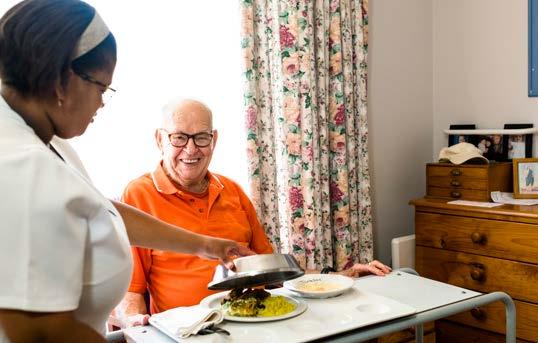
f Be aware of the placement of garbage cans and bus bins.
f When pre-portioning drinks or foods, cover them and maintain their temperature.
• Follow approved procedures for sanitation of food-contact surfaces. Inspect the following before each meal:

f Tables and chairs
f Menus
f Table linens
f Placemats
f Condiment holders
f Meeting safety and sanitation rules play a big role in service excellence.
f Never touch food or eating/drinking surfaces when carrying dishes.
f Handle dirty dishes separately from clean.
Creating the best customer experience is within your control.
Here are the five basics of customer service excellence. Together, they create the foundation of the WOW experience (“me” refers to the guest):
• Look at me.
• Smile at me.
• Greet me.
• Listen to me.
• Thank me.
For many guests, especially those in long-term care, you are serving food in their home. Positive experiences are an expectation.

• These steps help you manage guest experience.
• Great food won’t overcome a bad guest experience.
• Guests don’t have the choice to go elsewhere to eat.
People will have questions, so familiarity with menu offerings is important. To ensure a good experience:
• Taste the food with your team before meal service.
• Know what’s on the menu.
f Be able to explain daily features as well as the everyday offerings.
• Know how the food was prepared.
f Use descriptive words to enhance the items.
f Use everyday language and avoid technical terms.
• Know the portion sizes served.
• Know where you can find nutrition and allergy information.
Never enter or exit the kitchen empty-handed during service. Optimize your time by practicing a “full hands in, full hands out” method. Refilling water pitchers as you enter the kitchen and running other servers' food to the dining room helps others and keeps service running smoothly.
Working together is key to an optimal experience. Just think of what can be accomplished if every team member did one extra thing a day beyond these basics:

• Be on time and complete your share of work.
• Watch for team members who are overwhelmed or running behind.
f Always communicate with team members.
f Call on nursing or support staff, where available.
f Assist other team members if you are not busy.
• Respect other team members.
• Leave opinions aside during your shift.
Talking with teammates is part of service excellence. There are clear rules about communicating with each other on the dining room floor:
f Avoid personal conversations with other team members while helping guests.
f Excuse yourself from the guest if a need arises to converse with another team member.
f Never interrupt another team member when they are helping a guest.
f Never discuss guests in front of other guests.
f Never shout/talk across the dining room to each other.
f Practice the five basics of customer service.
f Communicate with your team.
f Create a positive dining experience.
Great customer service also means handling guest complaints. Brace yourself, prepare your team

No matter how hard you try, someone will complain. Work to fix the issue on the spot. Here are some best practices for managers and staff:
• Support your staff.
• Have an assigned delegate for complaints.
• Ensure the process is guest-centred and timely.
• Train your team on compliance policy, using a clear, timely process.
Source: Health Quality Ontario
• Keep calm, don’t take things personally.
• Allow your guest to present the problem.
• Show active listeningeye contact, pay attention.
• Confirm your understanding by paraphrasing.
• Do not challenge the complaint.
• Acknowledge mistakes with sincerity.
• Take responsibility and apologize.
• Genuinely thank your guest for bringing the problem to your attention.
• Offer solutions to take care of the problem immediately.
• Always smile. Do not argue, criticize, ignore, or challenge.
• Inform the manager about complaints and how they were resolved.
Source: Forbes.com
This describes what to do when dealing with unhappy guests:
f D - Don’t lose your cool
f E - Encourage customers to vent emotions

f F - Find out the facts
f U - Understand your guests’ feelings
f S - Suggest a way to fix the problem
f E - End on a positive note
Guests in care settings may complain about prescribed diet orders – a legitimate complaint, but one that must be deferred to clinical staff.
Here’s how to handle such complaints:
• Explain that prescribed therapeutic and consistency diet orders can only be changed by a member of the healthcare team.
• Suggest that concerns can be brought to the foodservice manager.
• Let the guest know you have escalated the issue.
• If food quality and safety standards are not being met, report it to your manager.
f Treat all complaints seriously because they matter to the guests.
f Don’t take complaints personally and thank guests for pointing them out.
Looking at your phone while with a guest is not acceptable. Keep your phone tucked away.
Best practices for times when actions mean more than words.
Unspoken messages
It’s not always what you say, but how you say it. Non-verbal cues, like body language and tone of voice, sometimes convey more meaning than words. Watch for the following:
POSITIVE BODY LANGUAGE
• Smile whenever appropriate.
• Keep your head up.
• Face the guest when communicating.

• Maintain eye contact but don’t stare.
• Nod occasionally when guests are talking.
• Stand with good posture, relax your shoulders.
• Keep a positive attitude.
• Lack of eye contact.
• Staring
• Arm-crossing
• Eye-rolling
• Frowning
• Poor posture
• Touching face
• Fidgeting
f Never underestimate the power of non-verbal cues to enhance or detract from communication.
f Make eye contact and acknowledge that you are listening.
Awareness builds a welcoming environment for your team and guests.
Our planet is a melting pot, and cultures are constantly merging. Here’s what you need to know:
• There is growing diversity in the aging population.
• There are lots of ways individual diversity shows itself.
f Ethnicity, ancestry or race
f Gender identity, expression or sexual orientation
f Age
f Socio-economic status
f Physical abilities
f Religious or political beliefs
f Neurodiversity
• Welcoming, person-centred care happens when caregivers recognize and understand diversity, keeping an open mind and staying curious about people and their experiences.
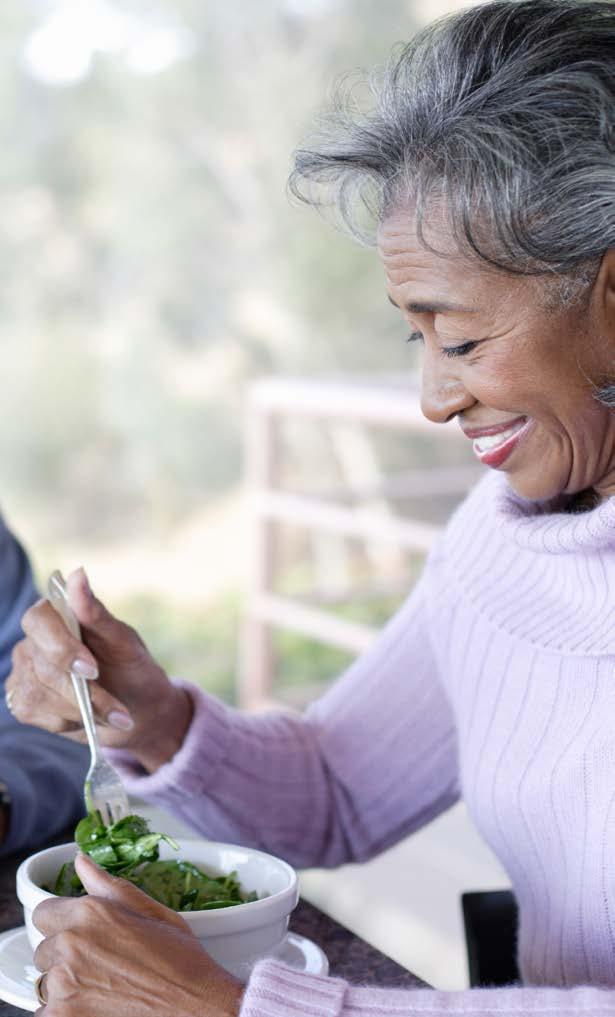
Source: Embracing Diversity Toolkit
• Avoid slang and use a shared language.
• Speak slowly and clearly.
• Don’t make assumptions.
• Be aware of any personal blind spots or biases.
• Practice effective communication skills.
• Be flexible – offer to write something down if needed (pictures, sample plates).
• Provide written translations to avoid misunderstandings.
• Be empathetic.
• Encourage feedback.
• Ask for clarification if needed.
• Understand religious needs – halal, kosher, etc.
f Naming of food
f The written language of that food item
f Traditional service ware (two-handed cup, chopsticks, etc.)
Source: Washington University School of Medicine in St. Louis
• Know your guest’s needs and accommodate them.
• Always ask the guest first before offering assistance.
• Recognize that not all disabilities are visible.

There is often a range of generations in each setting –sometimes up to five generations when you consider guests and staff. Recognize how this may impact communication.
• Consider differences in values and communication styles across generations.
• Each guest brings a unique lived experience and set of beliefs to interactions.
• Some guests prefer a more formal dining experience, others may have eaten by the TV at home.
• Here are some communication tips:
f Be curious and ask questions.
f Practice active listening.
f Avoid stereotypes and assumptions.
f Encourage feedback.
Guests may have varying levels of cognitive awareness. Better understanding of individuals can create a nurturing environment that helps to overcome obstacles to proper nutrition here are dining strategies to support guests with dementia:

• Interaction
f Address the individual directly.
f Focus on the individual, not the task.
f Be attentive, flexible and patient.
• Environment
f Ensure adequate lighting.
f Provide a calm environment.
f Limit ambient noise, such as TV.
f Keep the table setting simple. Avoid patterned plates, napkins, placemats and tablecloths.
f Assure the guest is positioned properly and everything is within reach.
f Use aromatherapy to stimulate appetite.
• Dining routine
f Keep things consistent.
f Allow plenty of time to eat.
f Provide food cues and encouragement as needed.
f Provide assistance with tasks such as cutting food and using condiments, as needed.
f Offer small, frequent meals.
f Consider the individual dining preferences. Refer to dining recommendations in their care plan.
Agitation can indicate the guest is not tolerating the meal. Watch for the following and involve the interdisciplinary care team (speech language pathologist, nurse, dietitian, physician) immediately:
• Frequent coughing with meals.
• Drooling.
• Wet (gurgling) sounds.
• Regurgitation of food.
• Complaining of feeling like food is stuck in the throat.
f Everyone is unique. Understanding that helps build a welcoming, person-centred environment.
f You’re likely to have many generations and value structures in your community.
f Create a nurturing environment to help guests with dementia or memory challenges.
